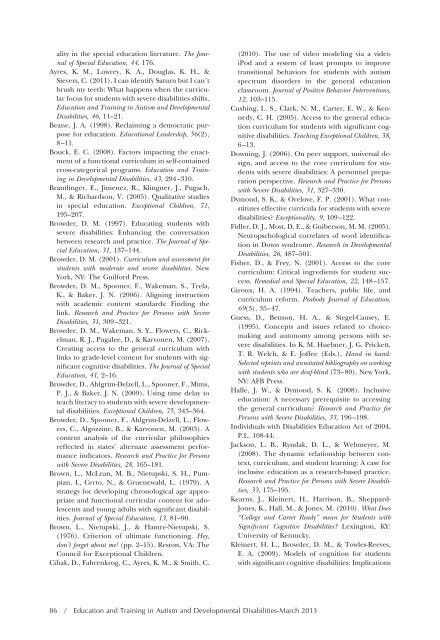etadd_48(1) - Division on Autism and Developmental Disabilities
etadd_48(1) - Division on Autism and Developmental Disabilities
etadd_48(1) - Division on Autism and Developmental Disabilities
You also want an ePaper? Increase the reach of your titles
YUMPU automatically turns print PDFs into web optimized ePapers that Google loves.
ality in the special educati<strong>on</strong> literature. The Journal<br />
of Special Educati<strong>on</strong>, 44, 176.<br />
Ayres, K. M., Lowrey, K. A., Douglas, K. H., &<br />
Sievers, C. (2011). I can identify Saturn but I can’t<br />
brush my teeth: What happens when the curricular<br />
focus for students with severe disabilities shifts.<br />
Educati<strong>on</strong> <strong>and</strong> Training in <strong>Autism</strong> <strong>and</strong> <strong>Developmental</strong><br />
<strong>Disabilities</strong>, 46, 11–21.<br />
Beane, J. A. (1998). Reclaiming a democratic purpose<br />
for educati<strong>on</strong>. Educati<strong>on</strong>al Leadership, 56(2),<br />
8–11.<br />
Bouck, E. C. (2008). Factors impacting the enactment<br />
of a functi<strong>on</strong>al curriculum in self-c<strong>on</strong>tained<br />
cross-categorical programs. Educati<strong>on</strong> <strong>and</strong> Training<br />
in <strong>Developmental</strong> <strong>Disabilities</strong>, 43, 294–310.<br />
Brantlinger, E., Jimenez, R., Klingner, J., Pugach,<br />
M., & Richards<strong>on</strong>, V. (2005). Qualitative studies<br />
in special educati<strong>on</strong>. Excepti<strong>on</strong>al Children, 71,<br />
195–207.<br />
Browder, D. M. (1997). Educating students with<br />
severe disabilities: Enhancing the c<strong>on</strong>versati<strong>on</strong><br />
between research <strong>and</strong> practice. The Journal of Special<br />
Educati<strong>on</strong>, 31, 137–144.<br />
Browder, D. M. (2001). Curriculum <strong>and</strong> assessment for<br />
students with moderate <strong>and</strong> severe disabilities. New<br />
York, NY: The Guilford Press.<br />
Browder, D. M., Spo<strong>on</strong>er, F., Wakeman, S., Trela,<br />
K., & Baker, J. N. (2006). Aligning instructi<strong>on</strong><br />
with academic c<strong>on</strong>tent st<strong>and</strong>ards: Finding the<br />
link. Research <strong>and</strong> Practice for Pers<strong>on</strong>s with Severe<br />
<strong>Disabilities</strong>, 31, 309–321.<br />
Browder, D. M., Wakeman, S. Y., Flowers, C., Rickelman,<br />
R. J., Pugalee, D., & Karv<strong>on</strong>en, M. (2007).<br />
Creating access to the general curriculum with<br />
links to grade-level c<strong>on</strong>tent for students with significant<br />
cognitive disabilities. The Journal of Special<br />
Educati<strong>on</strong>, 41, 2–16.<br />
Browder, D., Ahlgrim-Delzell, L., Spo<strong>on</strong>er, F., Mims,<br />
P. J., & Baker, J. N. (2009). Using time delay to<br />
teach literacy to students with severe developmental<br />
disabilities. Excepti<strong>on</strong>al Children, 75, 343–364.<br />
Browder, D., Spo<strong>on</strong>er, F., Ahlgrim-Delzell, L., Flowers,<br />
C., Algozzine, B., & Karv<strong>on</strong>en, M. (2003). A<br />
c<strong>on</strong>tent analysis of the curricular philosophies<br />
reflected in states’ alternate assessment performance<br />
indicators. Research <strong>and</strong> Practice for Pers<strong>on</strong>s<br />
with Severe <strong>Disabilities</strong>, 28, 165–181.<br />
Brown, L., McLean, M. B., Nietupski, S. H., Pumpian,<br />
I., Certo, N., & Gruenewald, L. (1979). A<br />
strategy for developing chr<strong>on</strong>ological age appropriate<br />
<strong>and</strong> functi<strong>on</strong>al curricular c<strong>on</strong>tent for adolescents<br />
<strong>and</strong> young adults with significant disabilities.<br />
Journal of Special Educati<strong>on</strong>, 13, 81–90.<br />
Brown, L., Nietupski, J., & Hamre-Nietupski, S.<br />
(1976). Criteri<strong>on</strong> of ultimate functi<strong>on</strong>ing. Hey,<br />
d<strong>on</strong>’t forget about me! (pp. 2–15). Rest<strong>on</strong>, VA: The<br />
Council for Excepti<strong>on</strong>al Children.<br />
Cihak, D., Fahrenkrog, C., Ayres, K. M., & Smith, C.<br />
(2010). The use of video modeling via a video<br />
iPod <strong>and</strong> a system of least prompts to improve<br />
transiti<strong>on</strong>al behaviors for students with autism<br />
spectrum disorders in the general educati<strong>on</strong><br />
classroom. Journal of Positive Behavior Interventi<strong>on</strong>s,<br />
12, 103–115.<br />
Cushing, L. S., Clark, N. M., Carter, E. W., & Kennedy,<br />
C. H. (2005). Access to the general educati<strong>on</strong><br />
curriculum for students with significant cognitive<br />
disabilities. Teaching Excepti<strong>on</strong>al Children, 38,<br />
6–13.<br />
Downing, J. (2006). On peer support, universal design,<br />
<strong>and</strong> access to the core curriculum for students<br />
with severe disabilities: A pers<strong>on</strong>nel preparati<strong>on</strong><br />
perspective. Research <strong>and</strong> Practice for Pers<strong>on</strong>s<br />
with Severe <strong>Disabilities</strong>, 31, 327–330.<br />
Dym<strong>on</strong>d, S. K., & Orelove, F. P. (2001). What c<strong>on</strong>stitutes<br />
effective curricula for students with severe<br />
disabilities? Excepti<strong>on</strong>ality, 9, 109–122.<br />
Fidler, D. J., Most, D. E., & Guibers<strong>on</strong>, M. M. (2005).<br />
Neuropschological correlates of word identificati<strong>on</strong><br />
in Down syndrome. Research in <strong>Developmental</strong><br />
<strong>Disabilities</strong>, 26, <str<strong>on</strong>g>48</str<strong>on</strong>g>7–501.<br />
Fisher, D., & Frey, N. (2001). Access to the core<br />
curriculum: Critical ingredients for student success.<br />
Remedial <strong>and</strong> Special Educati<strong>on</strong>, 22, 1<str<strong>on</strong>g>48</str<strong>on</strong>g>–157.<br />
Giroux, H. A. (1994). Teachers, public life, <strong>and</strong><br />
curriculum reform. Peabody Journal of Educati<strong>on</strong>,<br />
69(3), 35–47.<br />
Guess, D., Bens<strong>on</strong>, H. A., & Siegel-Causey, E.<br />
(1995). C<strong>on</strong>cepts <strong>and</strong> issues related to choicemaking<br />
<strong>and</strong> aut<strong>on</strong>omy am<strong>on</strong>g pers<strong>on</strong>s with severe<br />
disabilities. In K. M. Huebner, J. G. Prickett,<br />
T. R. Welch, & E. Joffee (Eds.), H<strong>and</strong> in h<strong>and</strong>:<br />
Selected reprints <strong>and</strong> annotated bibliography <strong>on</strong> working<br />
with students who are deaf-blind (73–80). New York,<br />
NY: AFB Press.<br />
Halle, J. W., & Dym<strong>on</strong>d, S. K. (2008). Inclusive<br />
educati<strong>on</strong>: A necessary prerequisite to accessing<br />
the general curriculum? Research <strong>and</strong> Practice for<br />
Pers<strong>on</strong>s with Severe <strong>Disabilities</strong>, 33, 196–198.<br />
Individuals with <strong>Disabilities</strong> Educati<strong>on</strong> Act of 2004,<br />
P.L. 108-44.<br />
Jacks<strong>on</strong>, L. B., Ryndak, D. L., & Wehmeyer, M.<br />
(2008). The dynamic relati<strong>on</strong>ship between c<strong>on</strong>text,<br />
curriculum, <strong>and</strong> student learning: A case for<br />
inclusive educati<strong>on</strong> as a research-based practice.<br />
Research <strong>and</strong> Practice for Pers<strong>on</strong>s with Severe <strong>Disabilities</strong>,<br />
33, 175–195.<br />
Kearns, J., Kleinert, H., Harris<strong>on</strong>, B., Sheppard-<br />
J<strong>on</strong>es, K., Hall, M., & J<strong>on</strong>es, M. (2010). What Does<br />
“College <strong>and</strong> Career Ready” mean for Students with<br />
Significant Cognitive <strong>Disabilities</strong>? Lexingt<strong>on</strong>, KY:<br />
University of Kentucky.<br />
Kleinert, H. L., Browder, D. M., & Towles-Reeves,<br />
E. A. (2009). Models of cogniti<strong>on</strong> for students<br />
with significant cognitive disabilities: Implicati<strong>on</strong>s<br />
86 / Educati<strong>on</strong> <strong>and</strong> Training in <strong>Autism</strong> <strong>and</strong> <strong>Developmental</strong> <strong>Disabilities</strong>-March 2013
















